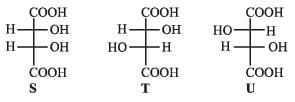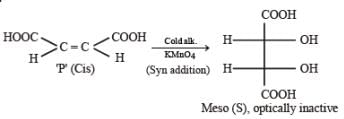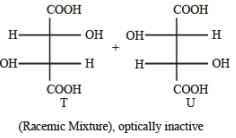JEE Exam > JEE Questions > PASSAGE-5P and Q are isomers of dicarboxylic ...
Start Learning for Free
PASSAGE-5
P and Q are isomers of dicarboxylic acid C4H4O4. Both decolorize Br2/H2O. On heating, P forms the cyclic anhydride. Upon treatment with dilute alkaline KMnO4, P as well as Q could produce one or more than one from S, T and U.

- a)Optically active S an d optically active pair (T, U)
- b)Optically in active S and optically in active pair (T, U)
- c)Optically active pair (T, U) and optically active S
- d)Optically inactive pair (T, U)) and optically inactive S
Correct answer is option 'B'. Can you explain this answer?
| FREE This question is part of | Download PDF Attempt this Test |
Verified Answer
PASSAGE-5P and Q are isomers of dicarboxylic acid C4H4O4. Both decolor...




|
Explore Courses for JEE exam
|

|
Similar JEE Doubts
PASSAGE-5P and Q are isomers of dicarboxylic acid C4H4O4. Both decolorize Br2/H2O. On heating, P forms the cyclic anhydride. Upon treatment with dilute alkaline KMnO4, P as well as Q could produce one or more than one from S, T and U.a)Optically active S an d optically active pair (T, U)b)Optically in active S and optically in active pair (T, U)c)Optically active pair (T, U) and optically active Sd)Optically inactive pair (T, U)) and optically inactive SCorrect answer is option 'B'. Can you explain this answer?
Question Description
PASSAGE-5P and Q are isomers of dicarboxylic acid C4H4O4. Both decolorize Br2/H2O. On heating, P forms the cyclic anhydride. Upon treatment with dilute alkaline KMnO4, P as well as Q could produce one or more than one from S, T and U.a)Optically active S an d optically active pair (T, U)b)Optically in active S and optically in active pair (T, U)c)Optically active pair (T, U) and optically active Sd)Optically inactive pair (T, U)) and optically inactive SCorrect answer is option 'B'. Can you explain this answer? for JEE 2024 is part of JEE preparation. The Question and answers have been prepared according to the JEE exam syllabus. Information about PASSAGE-5P and Q are isomers of dicarboxylic acid C4H4O4. Both decolorize Br2/H2O. On heating, P forms the cyclic anhydride. Upon treatment with dilute alkaline KMnO4, P as well as Q could produce one or more than one from S, T and U.a)Optically active S an d optically active pair (T, U)b)Optically in active S and optically in active pair (T, U)c)Optically active pair (T, U) and optically active Sd)Optically inactive pair (T, U)) and optically inactive SCorrect answer is option 'B'. Can you explain this answer? covers all topics & solutions for JEE 2024 Exam. Find important definitions, questions, meanings, examples, exercises and tests below for PASSAGE-5P and Q are isomers of dicarboxylic acid C4H4O4. Both decolorize Br2/H2O. On heating, P forms the cyclic anhydride. Upon treatment with dilute alkaline KMnO4, P as well as Q could produce one or more than one from S, T and U.a)Optically active S an d optically active pair (T, U)b)Optically in active S and optically in active pair (T, U)c)Optically active pair (T, U) and optically active Sd)Optically inactive pair (T, U)) and optically inactive SCorrect answer is option 'B'. Can you explain this answer?.
PASSAGE-5P and Q are isomers of dicarboxylic acid C4H4O4. Both decolorize Br2/H2O. On heating, P forms the cyclic anhydride. Upon treatment with dilute alkaline KMnO4, P as well as Q could produce one or more than one from S, T and U.a)Optically active S an d optically active pair (T, U)b)Optically in active S and optically in active pair (T, U)c)Optically active pair (T, U) and optically active Sd)Optically inactive pair (T, U)) and optically inactive SCorrect answer is option 'B'. Can you explain this answer? for JEE 2024 is part of JEE preparation. The Question and answers have been prepared according to the JEE exam syllabus. Information about PASSAGE-5P and Q are isomers of dicarboxylic acid C4H4O4. Both decolorize Br2/H2O. On heating, P forms the cyclic anhydride. Upon treatment with dilute alkaline KMnO4, P as well as Q could produce one or more than one from S, T and U.a)Optically active S an d optically active pair (T, U)b)Optically in active S and optically in active pair (T, U)c)Optically active pair (T, U) and optically active Sd)Optically inactive pair (T, U)) and optically inactive SCorrect answer is option 'B'. Can you explain this answer? covers all topics & solutions for JEE 2024 Exam. Find important definitions, questions, meanings, examples, exercises and tests below for PASSAGE-5P and Q are isomers of dicarboxylic acid C4H4O4. Both decolorize Br2/H2O. On heating, P forms the cyclic anhydride. Upon treatment with dilute alkaline KMnO4, P as well as Q could produce one or more than one from S, T and U.a)Optically active S an d optically active pair (T, U)b)Optically in active S and optically in active pair (T, U)c)Optically active pair (T, U) and optically active Sd)Optically inactive pair (T, U)) and optically inactive SCorrect answer is option 'B'. Can you explain this answer?.
Solutions for PASSAGE-5P and Q are isomers of dicarboxylic acid C4H4O4. Both decolorize Br2/H2O. On heating, P forms the cyclic anhydride. Upon treatment with dilute alkaline KMnO4, P as well as Q could produce one or more than one from S, T and U.a)Optically active S an d optically active pair (T, U)b)Optically in active S and optically in active pair (T, U)c)Optically active pair (T, U) and optically active Sd)Optically inactive pair (T, U)) and optically inactive SCorrect answer is option 'B'. Can you explain this answer? in English & in Hindi are available as part of our courses for JEE.
Download more important topics, notes, lectures and mock test series for JEE Exam by signing up for free.
Here you can find the meaning of PASSAGE-5P and Q are isomers of dicarboxylic acid C4H4O4. Both decolorize Br2/H2O. On heating, P forms the cyclic anhydride. Upon treatment with dilute alkaline KMnO4, P as well as Q could produce one or more than one from S, T and U.a)Optically active S an d optically active pair (T, U)b)Optically in active S and optically in active pair (T, U)c)Optically active pair (T, U) and optically active Sd)Optically inactive pair (T, U)) and optically inactive SCorrect answer is option 'B'. Can you explain this answer? defined & explained in the simplest way possible. Besides giving the explanation of
PASSAGE-5P and Q are isomers of dicarboxylic acid C4H4O4. Both decolorize Br2/H2O. On heating, P forms the cyclic anhydride. Upon treatment with dilute alkaline KMnO4, P as well as Q could produce one or more than one from S, T and U.a)Optically active S an d optically active pair (T, U)b)Optically in active S and optically in active pair (T, U)c)Optically active pair (T, U) and optically active Sd)Optically inactive pair (T, U)) and optically inactive SCorrect answer is option 'B'. Can you explain this answer?, a detailed solution for PASSAGE-5P and Q are isomers of dicarboxylic acid C4H4O4. Both decolorize Br2/H2O. On heating, P forms the cyclic anhydride. Upon treatment with dilute alkaline KMnO4, P as well as Q could produce one or more than one from S, T and U.a)Optically active S an d optically active pair (T, U)b)Optically in active S and optically in active pair (T, U)c)Optically active pair (T, U) and optically active Sd)Optically inactive pair (T, U)) and optically inactive SCorrect answer is option 'B'. Can you explain this answer? has been provided alongside types of PASSAGE-5P and Q are isomers of dicarboxylic acid C4H4O4. Both decolorize Br2/H2O. On heating, P forms the cyclic anhydride. Upon treatment with dilute alkaline KMnO4, P as well as Q could produce one or more than one from S, T and U.a)Optically active S an d optically active pair (T, U)b)Optically in active S and optically in active pair (T, U)c)Optically active pair (T, U) and optically active Sd)Optically inactive pair (T, U)) and optically inactive SCorrect answer is option 'B'. Can you explain this answer? theory, EduRev gives you an
ample number of questions to practice PASSAGE-5P and Q are isomers of dicarboxylic acid C4H4O4. Both decolorize Br2/H2O. On heating, P forms the cyclic anhydride. Upon treatment with dilute alkaline KMnO4, P as well as Q could produce one or more than one from S, T and U.a)Optically active S an d optically active pair (T, U)b)Optically in active S and optically in active pair (T, U)c)Optically active pair (T, U) and optically active Sd)Optically inactive pair (T, U)) and optically inactive SCorrect answer is option 'B'. Can you explain this answer? tests, examples and also practice JEE tests.

|
Explore Courses for JEE exam
|

|
Suggested Free Tests
Signup for Free!
Signup to see your scores go up within 7 days! Learn & Practice with 1000+ FREE Notes, Videos & Tests.























